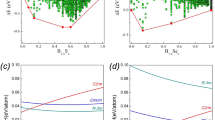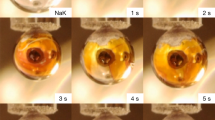Abstract
POTASSIUM, rubidium and cæsium form dark blue, hexagonal tungsten bronzes MexWO3, where the alkali content, which is probably somewhat variable, corresponds to values1 of x of about 0.3. The crystal structure of these compounds, which are isomorphous, has been established on the basis of an X-ray investigation of a single crystal of the rubidium bronze.
This is a preview of subscription content, access via your institution
Access options
Subscribe to this journal
Receive 51 print issues and online access
$199.00 per year
only $3.90 per issue
Buy this article
- Purchase on Springer Link
- Instant access to full article PDF
Prices may be subject to local taxes which are calculated during checkout
Similar content being viewed by others
References
Magnéli, A., and Blomberg, B., Acta Chem. Scand., 5, 372 (1951).
Magnéli, A., Nova Acta Regiae Soc. Sci. Upsaliensis, [4], 14, No. 8 (1950).
Wells, A. F., “Structural Inorganic Chemistry” (2nd edit., Oxford, 1950).
Magnéli, A., Arkiv Kemi, 1, 223 (1949).
Author information
Authors and Affiliations
Rights and permissions
About this article
Cite this article
MAGNÉLI, A. Tungsten Bronzes containing Six-membered Rings of WO6 Octahedra. Nature 169, 791–792 (1952). https://doi.org/10.1038/169791a0
Issue Date:
DOI: https://doi.org/10.1038/169791a0
Comments
By submitting a comment you agree to abide by our Terms and Community Guidelines. If you find something abusive or that does not comply with our terms or guidelines please flag it as inappropriate.



